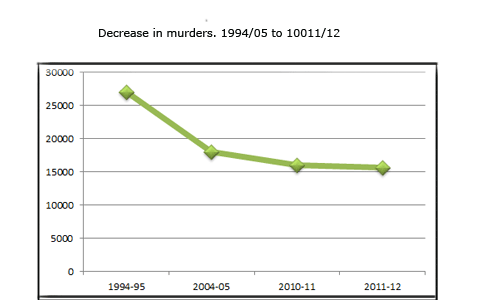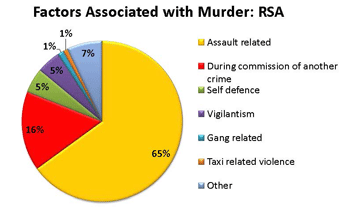There was a time not so long ago when many people perceived crime to be South Africa’s Achilles’ heel. For government, ensuring that all South Africans feel safe remains a priority on which we draw hope and motivation. We are further encouraged that in the last three years, most categories of crime have seen steady declines.
Announcing the 2011/12 South African Police Service (SAPS) National Crime Statistics last week, Police Minister Nathi Mthethwa asserted the country was turning the tide against crime. The facts support this assessment!
The April 2011 to March 2012 crime statistics show a marked decrease across most categories of crime.
The murder rate which stood at 27 000 for the period 1994/1995 has often been singled out as the biggest challenge facing SAPS.
In 2004/05, more than 18 000 murder cases were recorded. This figure dropped below 16 000 in 2009/10 when the current administration came into office.

This translates to a 27.6% reduction – more than a quarter – in murder over an eight-year period. In 2011/12 murder went down by 3.1% to 15 609. Further successes were noted as attempted murder decreased by 5.2% and assault with the intent to do grievous bodily harm decreased by 4.2%. Common assault decreased by 3.4%.
What the murder figures show once again is that police action and reaction is only one part of the story of crime in South Africa and that safety is a function of personal morality more than it is of policing.
Research by Crime Research and Statistics of the SAPS indicated that nearly two-thirds (65%) of murders started off as assaults resulting from interpersonal arguments, which were often aggravated by alcohol and drug abuse.

Successes have also been recorded against organised crimes such as carjacking, cash-in-transit heists and bank robberies all which have decreased.
Car hijackings declined by 11.9% with Mthethwa attributing this to police strategies paying off. He said motor vehicle theft and carjackings are often organised in nature and are frequently linked to the export of stolen or hijacked vehicles across the country’s borders.
“We are encouraged by the work done by crime intelligence, working with various SAPS units and this collaboration resulted in a number of arrests thus disrupting and halting some of these syndicates,” Mthethwa said.
Business and banks can take comfort from a dramatic decrease in cash-in-transits, which dropped by 37.5% as a result of better coordination and information-sharing between the SAPS and partners.
In 2011/12 bank robberies decreased by 10.3% similar to ATM bombings which decreased by more than a third (34.6%).
Gareth Newham, head of the crime and justice programme at the Institute for Security Studies welcomed the reduction in crime.
He said: “Although many crime categories are still at very high levels, in some respects we are heading in the right direction, adding that “substantial reductions in violent crime, such as car and truck hijacking, bank robberies, and cash-in-transit heists demonstrated that in some areas, police were improving.”
Although the overall picture is heartening, robbery with aggravating circumstances went up by 12%.
Mthethwa was dissatisfied with this reversal, to which he said SAPS would pay more attention.
Business robberies too showed an increase of 7.5% – the majority of these robberies taking place at small businesses. Mthethwa said government viewed crimes against small business as a priority that required a comprehensive and holistic strategy to ensure that the phenomenon was addressed in all its dimensions.
Although sexual offences decreased by 3.7% in 2011/12, the overall rate still remains stubbornly high and women and children are particularly vulnerable. Government is concerned about the scourge of rape which showed a marginal decrease of 1.9%.
The minister said more resources and better training were being put in place to tackle the issue.
In 2009 the Family Violence, Child Protection and Sexual Offences (FCS) units were re-established to address the challenges faced by women, children and the elderly.
This resulted in the training of specialised officers to deal specifically with sexual offences. In addition new and refurbished police stations will have dedicated special areas for victims of such crimes.
A working relationship with the judiciary has been established to have such cases prioritised.
The FCS unit has scored major victories over the last two years. In cases involving children under the age of 18, the unit has secured convictions that resulted in total of 10 345 years for those criminals. In the same age group it has secured 175 life sentences for these crimes.
In cases involving victims that are eighteen years and older, the unit has secured convictions that resulted in total of 10 854 years of imprisonment. In the same age category it has secured 131 life sentences.
This excludes cases that are still on the court roll. The most vulnerable in our society deserve care and protection. Ending violence against women and children is a struggle that we will continue to wage.
As a nation that cares, we need all of us to come together and work with the police in stemming this heinous crime. We need more of the victims to come forward and report cases of sexual offences.
On Women’s Day last month, President Jacob Zuma highlighted government’s commitment to reducing crimes against women and children.
There has been marked progress as reflected in the 2011/12 crime statistics. However, there are still many areas of concern and there is room for much improvement.
Phumla Williams is Acting CEO of the Government Communications and Information System (GCIS)




